Simple Chucking
Socket & Spigot Marking Gauges
by Chas Jones
In Woodturning most
things vary every time you pick up a piece of wood, one thing that stays
consistent and does not vary over time are the jaw dimensions of your chosen
chuck system. This fact means that if you make some simple marking gauges you
only ever need to research and measure the distances once, leaving the use of callipers,
rules etc. to the more creative tasks.
First things first,
research the nominal dimensions specified for your particular jaws, these are
the dimensions that give you the optimum jaw to wood contact without bruising
the socket or spigot., they can usually be found in drawing form in the
manufactures literature, or at the very least listed some where in the text.
If all else fails you
will need to set your jaws in a position that gives a true circle and check the
internal and external dimensions.
Basic construction
details of my simple Socket and Spigot marking gauges
(click on any image for a larger view)
The dimensions for the pencil
guides will obviously have to be adjusted to suit your particular jaws, in use
it is easy to make slight adjustments to the final dimensions of the sockets
and spigots based on the obtained guide marks to suit a particular task or as
in my case cover the difference between an optimum 69 and 72 mm for the differing
jaws shown above, I also have one little used spigot set that is just 4mm bigger
than my regular 56mm, I cover this by enlarging the spigot by eye. (I have
reminder note on the gage)
|
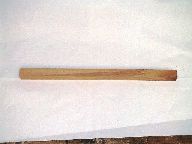
|
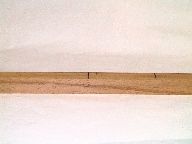
|
|
Select and
prepare a suitable piece of Beech or similar wood from the scrap box, 15-20mm
sq x 200mm or more long, (5/8-3/4 x 8")
|
Mark out 2
sections, In this case I have marked them at 90mm and 80mm long.
(3 1/2-3
1/8")
(I prefer them to be
differing lengths to aid visual selection from the tool draw.)
|
|
Now mark a distinct reference cut line on the top face (fill with pencil) 10mm
(3/8") from the right hand end of each section, and transfer a witness
line down the face and establish a centre mark on this face line.
Select 2 suitable Panel Pins or Brads and selecting a drill size slightly
smaller than their diameter, drill 2 holes through the face of the piece
on the centres marked, (pillar drill preferred to ensure they are square.)
|
|
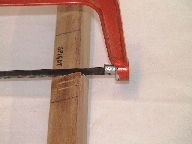
|
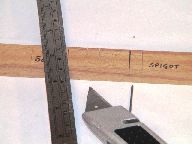
|
|
Using the
reference line as the datum, mark with a marking knife the required radius
dimensions along the top face to suit your jaws. This is a good time to annotate
the gauge sections as Socket and Spigot to avoid confusion.
Having marked and
checked the dimensions make a series of cuts with a fine saw blade at an angle
as shown above centred on the radius markings.
|
Now with a
sharp Craft knife or chisel cut a Vee at each saw cut position wide enough to
take a sharpened pencil.
|
|
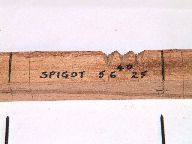
|
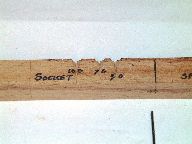
|
|
Mark the Vees
' with the respective Spigot
|
and Socket diameters.
|
|
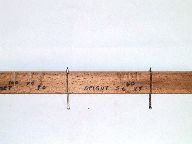
|
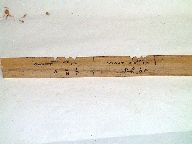
|
|
Now drive the
Panel Pins through the previously drilled holes until the points protrude on
the back face 2-3mm (1/16-3/32")
|
Cut off
surplus pin heads and file smooth.
Jaw type codes can
be added to this face as reminders for those times when an intellectual aberration
occurs.
|
|
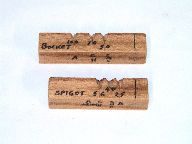
|
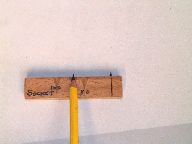
|
|
All that remains is to saw the two sections to length and
round off the sharp corners for the sake of the fingers, I prefer not to sand
the ends too smooth as an aid to handling.
|
This is how the marking pencil is presented after locating the pin point in a
witness centre marked with a skew chisel or similar as shown below.
|
|
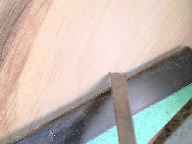
|
|
|
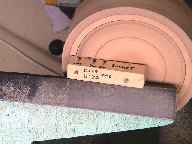
|
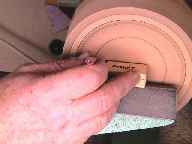
|
|
Here you can see an earlier incarnation in
use. Note the lathe is spinning in both shots
|


